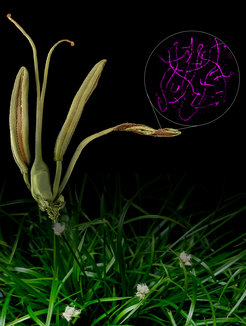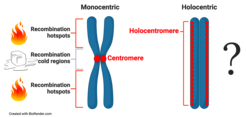New insights in the regulation of genetic information exchange
A research team led by André Marques from the Max Planck Institute for Plant Breeding Research in Cologne has identified chromosome pairing as key in the control for the distribution of genetic material. The study is now published in the journal Nature Plants.

Within every cell in our body, our DNA, the building blocks of every organism, is tightly bundled with proteins to form structures known as chromosomes. The commonly known shape of a chromosome relates to an X-shaped appearance in many organisms. The formation of the X-shaped chromosome results from a close connection at a site called the centromere. This centromere acts as a link between the sister chromatids, the identical copies that are created during DNA replication.
During reproduction, homologous chromosomes, chromosomes of the same shape and genetic set-up, pair-up and exchange genetic information. This DNA exchange is known as crossing-over, a process in which genetic material from the father and mother are mixed to ensure genetic diversity among the offspring. It is known, that crossing over activity is reduced at the centromeric regions and is more likely to happen in the areas distant to the centromere. Thus, genetic recombination of genes close to the centromere does not occur. This phenomenon is known as the ‘centromere effect’, suggesting the centromere itself may influence the crossing over activity and distribution. However, what mechanisms exactly are controlling the distribution of crossing over is still elusive.
Chromosomes with hundreds of centromeres

The research team around André Marques could now shed further lights into the controlling mechanisms of genetic recombination.In this study the scientists used the beak-sedge, a grass-like flowering plant (Rhynchospora breviuscula), an excellent natural toolbox to study the formation of genetic recombination. The model plant, in comparison to plants with single centromere chromosomes (monocentric plants), consists of chromosomes with hundreds of small centromeres, which are arranged in a line across the chromosome. Consequently, by using this so-called holocentric chromosome, the researchers are ruling out the influence of a localized centromere as well as the compartmentalized organization of the chromosome, with centromeres and genes equally distributed throughout the chromosome.
For the first time researchers were able to set-up a genetic recombination map, analyzing crossing over occurrence in a holocentric plant. In contrast to monocentric chromosomes crossing over activity occurred also in the proximity of the centromere. Strikingly, however, crossing over was uneven distributed across the chromosomes, with higher concentration towards the end of the chromosomes. Additionally, the team demonstrated that the distribution of crossing overs remained mostly unaffected by the global distribution of genetic and epigenetic chromosomal features.
Thus, the centromere region as well as epigenetic regulations do not seem to be the main driver to control crossing over distribution. Instead, Marques and his team propose that the behavior during the pairing-up of homologous chromosomes is the main force for crossing over control, with the telomeres, specific structures found at the ends of each chromosome, being the key player.
The team's discoveries are particularly promising for modern plant breeders who depend on genetic exchange of genes for both favorable and unfavorable traits, a current bottle neck for genes located close to the centromere in monocentric plant due to the centromere effect.
“Understanding how plants with diffuse centromeres regulate crossing over activity is of primary interest to engineer meiotic recombination in the context of plant breeding, for instance, by triggering the genetic exchange in regions that largely do not recombine at all”, says Marques.













